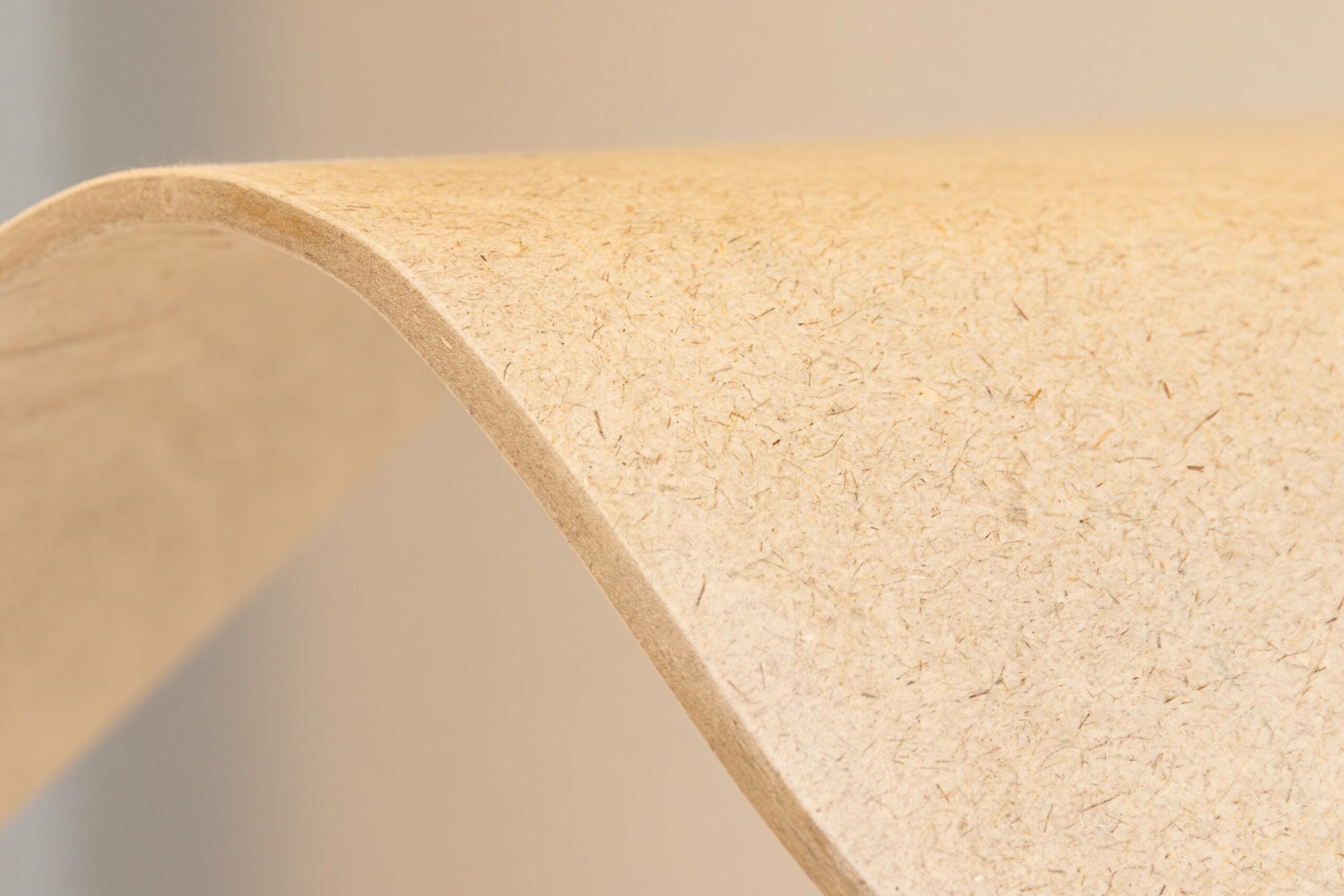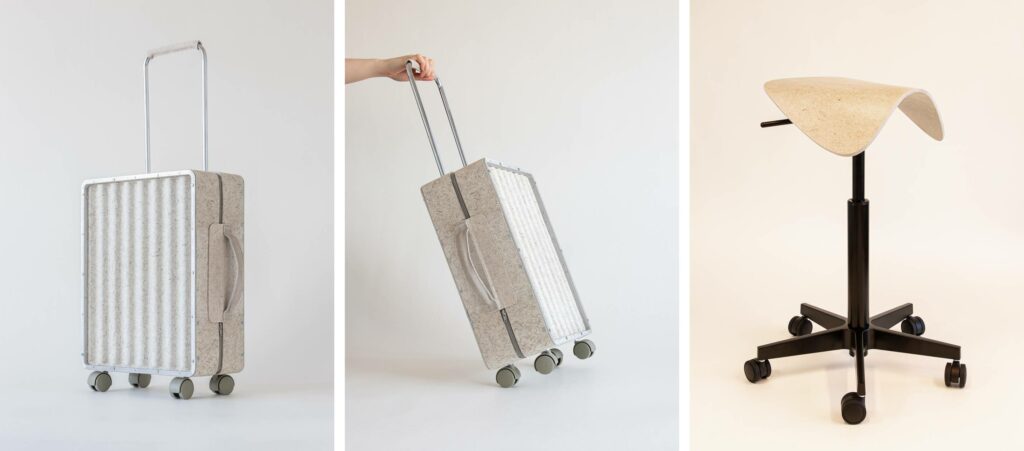
HiPer project advanced novel cellulose-based biocomposite materials one step closer towards commercialisation
ProjectsThe main target of the Business Finland Co-Innovation project HiPer (High Performance Cellulose-Based Composites) was to generate a completely new product portfolio based on lightweight and sustainable composite materials, which would be suitable for several industrial sectors, such as construction, automotive, transportation, furniture and packaging. The project consortium, led by VTT Technical Research Centre of Finland and consisting altogether of nine Finnish companies, expected to generate new material and process solutions that will provide a competitive advantage for the Finnish industry, leading to new and increased business in the international thermoplastic composite markets for Finnish companies.
ExpandFibre team was very happy to invite HiPer project manager Miika Nikinmaa, Lead of Biomaterial Solutions at VTT and Kristian Salminen, Lead of Bio-based products at VTT to share highlights from the two-year project. Joining the discussion were representatives from HiPer’s industrial partners including Riitta Ahokas, R&D Manager at Koskisen Oy, Sirpa Välimaa, Head Business Segment Pulp, Paper and Board at Sulzer Pumps Finland, and Jukka Rantanen, Business Development Manager at Sulzer Pumps Finland Oy. Kirsi Hirvonen, Development Manager, Business Development at Metsä Fibre, also provided separately additional insights for the ended project.
During the HiPer project VTT applied the foam forming technology – more commonly used in papermaking – to develop a novel biocomposite material also titled HiPer that can be potentially used in multiple high volume end uses such as in furniture applications, as already jointly demonstrated by project partners VTT and ISKU. According to VTT the novel biocomposite material can be easily moulded into complex three-dimensional shapes and even worked with conventional woodworking tools, thus making it an ideal drop-in solution for the furniture industry. Approximately 30-50 % of HiPer material consists of wood pulp and 20 % of long, cellulose-based fibres, such as flax, cotton, hemp or regenerated cellulose fibres, such as viscose or lyocell. Finally, the novel biocomposite contains 30-50 % of a thermoplastic binding agent, which can be recycled by melting and re-forming.

Setting sights already towards future initiatives
At the time of the joint discussion in December 2024, the project had already been successfully closed and reported to the primary funding body Business Finland as Miika explained: “Indeed the project has been finalised already earlier in 2024, and the reporting has been successfully closed with Business Finland. Currently we’re very actively putting the final pieces together for a project proposal aiming to continue the work of HiPer from another angle. Within HiPer the research ecosystem was performing very well, but we identified certain gaps in the business ecosystem surrounding the project, which had an impact on the amount of biocomposite materials that we could provide for the partners during the project. Our main target for the continuation of HiPer is to have these crucial gaps filled leading hopefully to exportable products. Perhaps most importantly, during the HiPer project we were able to identify that the novel biocomposite products and the developed foam forming process to manufacture them were promising enough to continue the work towards commercialisation.”
VTT’s HiPer project team and ExpandFibre organized a joint event in April 2024 exploring the topic of biocomposites, which also helped to assess the continuation of HiPer as Kristian explained: “The biocomposites themed event day in April 2024 was a success overall. Together with the event participants we were able to identify a long list of potential end use areas for biocomposites of which the building sector and the automotive industry were the most promising. Collectively within the project team we have gathered all the main learnings from HiPer and we’re very excited to submit the proposal for the continuation project hopefully in early 2025 and if it receives a favourable evaluation, we could kick things off in autumn 2025.”
Miika continued on the topic: “Already today, VTT has excellent capabilities for manufacturing the novel HiPer biocomposite material on a pre-commercial scale, but as we move towards industrial-scale demonstration from kilogram scale towards tonnes, it becomes clear that we have major upscaling challenges ahead of us. Also, it’s quite evident that the industrialisation and commercialisation of a new biomaterial innovation does not take place within a Co-Innovation project but requires a completely new set of collaborators in the form of investors, financiers and banks. What I’m happiest about is that we have a strong product, and we have successfully identified several key application areas for us to go forward. Dual-use is also something that we’re very much looking into currently and would need additional partners to supplement current consortium. I’m also very excited about the tailorability of the foam forming technology, which will most likely bring us even more functionalities into the product that have not been seen before as we develop it further.”
Both Kristian and Miika agreed that sufficient market pull for the novel HiPer material plays a key role in the future commercialisation efforts including finding a dedicated partner supplying the critical foam forming technology on an appropriate scale to manufacture the HiPer material, as Miika summarised: “The market has an essential role as a key enabler for us. The manufacturing will be scaled up as long as there is strong belief in the market for this product and its possibilities.”
Insights from the industrial partners
Jukka and Sirpa continued to reflect on the HiPer project from the perspective of Sulzer Pumps Finland, a key provider of technological solutions for multiple heavy industries such as the pulp, paper and board industries.
Jukka explained: “We had our own parallel company project in which we collaborated intensively with VTT. Our work focused largely on the research of the foam forming process and carrying out various foam trials at our Jyväskylä facility. More specifically we concentrated on the exploration of foam as a process medium and how different properties such as foam density and fibre content affect the properties of the final biocomposite product. In general, I’d say that HiPer was a very interesting project for us, and as a company we could have been even more active in the project, which is a key learning for us, and we’ll strive to improve upon that aspect for upcoming projects.”
Sirpa continued: “When I joined Sulzer the project was already ongoing, but I was still very happy that we were successful in our joint demonstrations with ISKU and Koskisen Oy. Overall, I’d say that foam is highly interesting for Sulzer going forward, and we have learned important lessons during the project especially regarding what is expected from a technology provider. Already today we are able to provide machinery for foam forming, but we need to keep learning all the time, especially on the upscaling challenges related to foam forming technology in particular, and the different requirements that are set for both batch-type and continuous foam forming processes.”
Jukka added: “All the technological solutions for foam forming that Sulzer has supplied so far have been different, and I have a strong belief that tailoring of the equipment will also play a key role in the future.”
Riitta also reflected on the HiPer initiative from the viewpoint of Koskisen Oy, an international wood processing specialist providing sawn and processed timber products to customers globally: “Within HiPer we were introduced to completely new materials, which was very interesting for us. However, there were definite challenges in providing the partners with materials on a sufficient scale, which had an impact on our work. The foam forming technology is very interesting, and it’ll be exciting to follow its development and what sort of materials could be introduced into the process going forward. In general we’re always interested in learning more about combining novel materials with traditional wood products, which are at the core of our expertise. As Jukka also previously mentioned, our participation in the project could have also been more active, which might have had an impact on guiding the project’s results more towards our interests. In general combining plastic-like materials with wood is highly interesting, giving more durability to traditional wood products and in the process creating completely new products.”
Miika agreed that there were definite challenges related to capacity and supplying the partners with enough biocomposite materials for an industrial evaluation during the project, which is one of the key takeaways for the next phase of HiPer.
Kirsi Hirvonen provided insights on the project from the viewpoint of a wood pulp provider representing Metsä Fibre: “As biocomposites were one of the key themes on the ExpandFibre R&D&I roadmap, HiPer was an important initiative to be a part of. As Metsä Fibre we were very interested to follow the development of the foam forming technology and Metsä Fibre’s own wood pulp portfolio’s role in it, but unfortunately it became quite clear that the traditional softwood pulp that we provide was not an optimal raw material for the foam-based process. However, we were very happy to make interesting new connections with the project partners, which will likely be very beneficial for us in the future. Perhaps one additional discovery during the project for us was the research work carried out on fire resistance. Traditionally fibre-based materials have had poor fire resistance properties limiting their use in some key application areas in the automotive industry and the building industry, for example. I’m eagerly waiting for more research and insights into this topic. Another important aspect of biocomposites is their recycling, which was not one of the focus areas of the HiPer project. As polymers and fibre-based materials have very different recycling requirements and recycling schemes, I’d like to see more efforts put into solving these challenges in the future, especially as these materials get more prevalent.”
Final remarks from the coordinators
To conclude the discussion on the project both Miika and Kristian agreed that the foam forming process played a key enabler’s role in the project, as foam forming allowed three distinct factors to align, namely the use of longer fibres, utilisation of different types of raw materials and the use of various surface chemistries to adjust the final surface properties of the finished HiPer material.
Miika summarised: “Everyone we have discussed with have been impressed by the HiPer material and in particular how tailorable the finished product was. In general I’m very grateful for the HiPer project partners, in particular ISKU, Volare Plastic and NMC Cellfoam, who were willing to pursue examining the novel material in collaboration with their value chain partners. Understandably for big brands it’s always very risky to introduce completely new materials, and we’re aware of this. In the future we have to have really strong arguments in place for both the environmental benefits and the functionality of the HiPer material, in order to gain momentum inside Finland and more importantly abroad. I’m very much looking forward to the work ahead.”
Kristian offered his final insights: “I’ve been lucky to take part in numerous research and innovation projects over the years, and it’s quite rare that the three key aspects of successful product development are reached. With the HiPer material we’re creating products with high strength and functionality by using less plastic and more cellulosic materials leading to environmental benefits, and according to early evaluations all this is achieved at a very competitive price. I consider that a significant achievement for the project.”
Article photos by HiPer project / VTT. Photo credit: Niina Hyry.
HiPer project fact sheet
Project duration: 05/2022 – 04/2024
Project type: Business Finland Co-Innovation. Parallel company projects for Paptic, Sulzer & Valmet.
Project partners: VTT Technical Research Centre of Finland (coordinator), CH-Polymers, ISKU, Koskisen, Metsä Fibre, NMC Cellfoam, Paptic Ltd., Sulzer, Valmet & Volar Plastic
Linked Ecosystems: ExpandFibre & Valmet’s Beyond Circularity
Project homepage: https://hiperproject.com/
Press releases for HiPer: VTT, ISKU & Finnish Forest Association